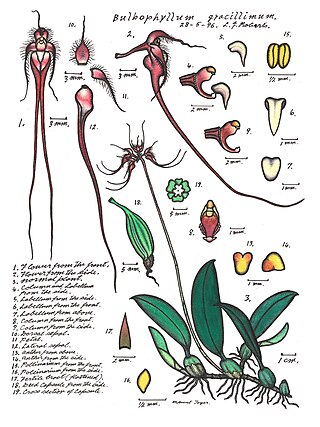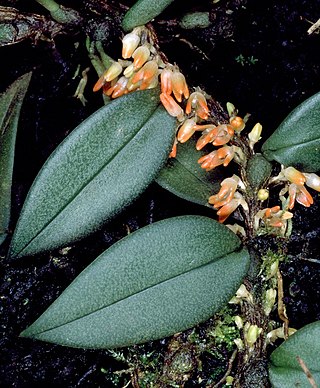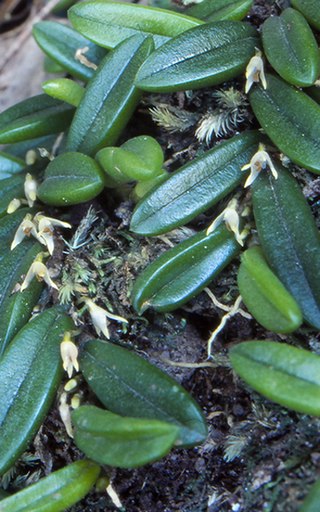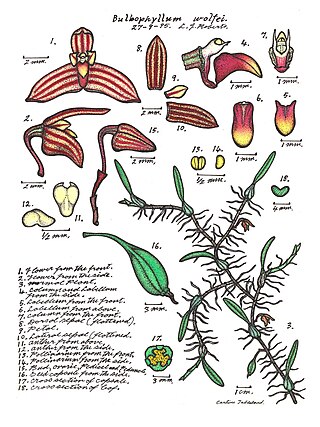
Bulbophyllum is a genus of mostly epiphytic and lithophytic orchids in the family Orchidaceae. It is the largest genus in the orchid family and one of the largest genera of flowering plants with more than 2,000 species, exceeded in number only by Astragalus. These orchids are found in diverse habitats throughout most of the warmer parts of the world including Africa, southern Asia, Latin America, the West Indies, and various islands in the Indian and Pacific Oceans. Orchids in this genus have thread-like or fibrous roots that creep over the surface of trees or rocks or hang from branches. The stem is divided into a rhizome and a pseudobulb, a feature that distinguished this genus from Dendrobium. There is usually only a single leaf at the top of the pseudobulb and from one to many flowers are arranged along an unbranched flowering stem that arises from the base of the pseudobulb. Several attempts have been made to separate Bulbophyllum into smaller genera, but most have not been accepted by the World Checklist of Selected Plant Families.

Eulophia pulchra, commonly known as the gonzo orchid, is a plant in the orchid family and is native to areas from Tanzania and Mozambique to the Western Pacific Ocean. It is a terrestrial orchid with crowded, above-ground pseudobulbs, two or three leaves and pale yellowish green flowers with dull purple or red markings. It grows in plant litter in rainforests.
Bulbophyllum argyropus, commonly known as the silver strand orchid, is a species of epiphytic or sometimes lithophytic orchid that is endemic to eastern Australia, including Lord Howe and Norfolk Islands. It has crowded pseudobulbs, tough, dark green leaves and up to four small whitish to yellowish flowers with an orange labellum.

Bulbophyllum baileyi, commonly known as the fruit fly orchid, is a species of epiphytic or lithophytic orchid that is native to Queensland and New Guinea. It has coarse, creeping rhizomes, curved, yellowish pseudobulbs with a single thick, fleshy leaf, and a single cream-coloured flower with yellow, red or purple spots. It grows on trees and rocks in open forest, often in exposed places.
Bulbophyllum caldericola is a species of epiphytic or lithophytic orchid with inconspicuous, well-spaced pseudobulbs arranged along rhizomes which mostly hang from the surface on which they are growing. Each pseudobulb has a single, fleshy, channelled leaf and a single white flower with yellow tips. It grows on the trunks and larger branches of rainforest trees near the eastern border between New South Wales and Queensland.

Bulbophyllum elisae, commonly known as the pineapple orchid, is a species of epiphytic or lithophytic orchid that is endemic to eastern Australia. It has crowded, wrinkled, pale green or yellowish clump-forming pseudobulbs, stiff, pale green to yellowish leaves and between three and twelve pale green to dark green flowers with a dark red to purple labellum. It usually grows in the tops of rainforest trees, on cliff faces or boulders.
Bulbophyllum evasum, commonly known as the creeping brittle orchid, is a species of epiphytic or lithophytic orchid with creeping brittle rhizomes, small, stubby pseudobulbs and dark green, fleshy leaves. The flowers are small, pink to reddish with dark stripes and yellow tips, clustered on the end of a dark red flowering stem. This orchid grows in rainforest on tree trunks and branches as well as on rocks, in tropical North Queensland.

Bulbophyllum gracillimum, commonly known as the wispy umbrella orchid, is a species of epiphytic orchid. It has a creeping rhizome, widely spaced, olive green pseudobulbs, each with a single thick, leathery, fleshy leaf and between six and ten purplish red flowers spreading in a semicircular umbel. The flowers have distinctive long, thread-like tails on the lateral sepals. It has a wide distribution and is found in New Guinea, New Caledonia, Indonesia, Malaysia and part of tropical North Queensland.
Bulbophyllum lageniforme, commonly known as the smooth strand orchid, is a species of epiphytic or lithophytic orchid that is endemic to tropical North Queensland. It has flattened, pale green, grooved, clump-forming pseudobulbs, stiff, dark green leaves and up to four cream-coloured or pale green flowers with a pink labellum. It usually grows on shrubs, trees and rocks in highland rainforest.
Bulbophyllum lamingtonense, commonly known as the cream rope orchid, is a species of epiphytic or lithophytic orchid with well-spaced pseudobulbs and brown bracts arranged along the stems. Each pseudobulb has a single, fleshy, channelled leaf and a single cream-coloured or white flower with yellow tips. It grows on trees and rocks near cliffs and the edge of rainforest near the eastern border between New South Wales and Queensland.
Bulbophyllum lilianae, commonly known as the warty strand orchid, is a species of epiphytic or lithophytic orchid that is endemic to tropical North Queensland. It has widely spaced, deeply grooved, dark green to yellowish pseudobulbs, thin but tough, dark green to yellowish leaves and up to three cream-coloured, pale green or reddish flowers with dark red stripes and a pink labellum. It grows on shrubs, trees and rocks, often in exposed situations.
Bulbophyllum macphersonii, commonly known as eyelash orchids, is a species of epiphytic or lithophytic orchid that is endemic to Queensland. It has tiny, crowded, slightly flattened, dark green pseudobulbs, a single thick, fleshy leaf and a single dark red to purplish red flower with a narrow labellum. It grows on trees and rocks in sheltered places.
Bulbophyllum minutissimum, commonly known as the red bead orchid or grain-of-wheat orchid, is a species of epiphytic or lithophytic orchid with small, flattened, reddish or green pseudobulbs, scale-like leaves and small whitish to reddish flowers with broad dar red stripes. It grows on trees and rocks, mostly in swamps and near streams in eastern Australia.
Bulbophyllum nematopodum, commonly known as the green cowl orchid, is a species of epiphytic or lithophytic orchid that has small, flask-shaped pseudobulbs pressed against the surface on which it grows. Each pseudobulb has roots at its base, a single shiny, fleshy leaf and a single cream-coloured flower with red spots on its top. It grows on trees and rocks in rainforest and is endemic to tropical North Queensland.

Bulbophyllum newportii, commonly known as the cupped strand orchid, is a species of epiphytic or lithophytic orchid that is endemic to tropical North Queensland. It has widely spaced, oval or cone-shaped, light green pseudobulbs, a single stiff, dark green egg-shaped leaf and up to eight bell-shaped white, cream-coloured or greenish flowers with a long, narrow yellow labellum. It grows on trees and rocks, usually at moderate to high elevations.
Bulbophyllum radicans, commonly known as the striped pyjama orchid, is a species of epiphytic or lithophytic orchid with long, hanging stems with roots near the base and covered with brown, papery bracts which partially hide the pseudobulbs. Each pseudobulb has a single thin leaf. A single small pink, cream-coloured or yellow flower with red or purplish stripes is borne on a thin flowering stem that emerges from the base of the pseudobulb. This orchid grows on trees or rocks in or near rainforest in tropical North Queensland.

Bulbophyllum schillerianum, commonly known as the red rope orchid, is a species of epiphytic or lithophytic orchid. It has well-spaced pseudobulbs each with a single grooved leaf and cluster of small, red or orange flowers with a hairy labellum. It grows on trees and rocks sometimes in rainforest but also on trees in cleared paddocks, and is endemic to eastern Australia.

Bulbophyllum shepherdii, commonly known as the wheat-leaf rope orchid, is a species of epiphytic or lithophytic orchid that forms a dense mat of branching rhizomes pressed against the surface on which it grows. The pseudobulbs are well spaced along the rhizome, each with a single egg-shaped leaf and a single small, white or cream-coloured flower with yellow tips. It grows on trees and rocks in rainforest and is endemic to eastern Australia.

Bulbophyllum wadsworthii, commonly known as the yellow rope orchid, is a species of epiphytic or lithophytic orchid that forms clumps that hang off the surface on which the plant is growing. The pseudobulbs are small and partly hidden by brown, papery bracts. Each pseudobulb has a single fleshy, dark green leaf and a single star-shaped, cream-coloured or pale green flower with an orange labellum. It mainly grows on trees and rocks in rainforest and is endemic to Queensland.

Bulbophyllum wolfei, commonly known as the fleshy snake orchid, is a species of epiphytic or lithophytic orchid with thin, creeping rhizomes, and flattened pseudobulbs each with a single thick, fleshy, dark green leaf and a single cream-coloured flower with dark red stripes. It mostly grows on rainforest trees in tropical North Queensland.











